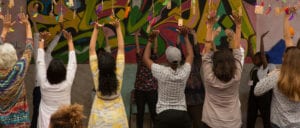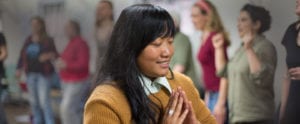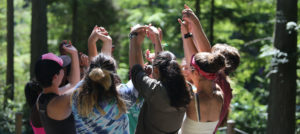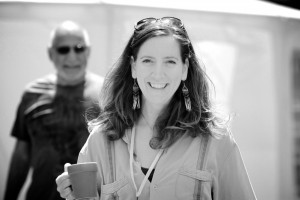
Sagesse Graham is a videographer and animator who uses aspects of the Creative Community Model in her work with youth. She is currently working at Fresh Takes as Director of Programming and Instruction and has 15 years of experience using the arts to work with youth. Sagesse has been connected to Partners for Youth Empowerment and Power of Hope ever since she attended the first ever camp as a youth in 1995.
Having experienced camp as a youth as well as working with Power of Hope for years as an intern and staff member, I was inspired and embodied the work from a young age. It became an integral part of my career and education very early on. I decided to take the Heart of Facilitation (HOF) training to continue to expand and deepen my knowledge and to see how my early mentors and colleagues were continuing to grow the field. My experiences with the Creative Community Model have affected all of the work that I do. I now integrate the holistic, inter-disciplinary models into every aspect of my work with youth and I try to create buy-in really early on to make sure that we have a community rather than just a group of people. When a young person arrives at my workshops or into one of my classes, my real aim is to get them out of fight or flight mode and into imagination mode as quickly as possible.
In September 2012, I began working at Fresh Takes. Even though I’m working with video and animation, I use various workshop techniques, mainly theater-based, so that kids feel comfortable and creative and so that the imagination is invoked early on.
At Fresh Takes we’ve partnered with Summit Public Schools, an organization that runs a total of four charter schools throughout North California. Because they are a college prep school they do not offer arts electives so twice a year they send their students out to community organizations like ours to earn the elective credits needed to graduate.. It’s great because I get to spend two months working full time with the same group.
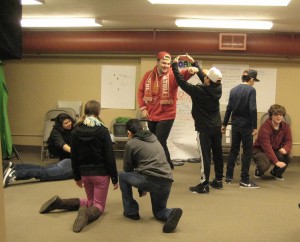
For this particular program, the kids come from two different high schools so it’s really important to get them to join together and act like a single community as quickly as possible. Using the techniques I learned at HOF I have a high success rate. I always use the classic community agreements so that the young people start to have a sense of ownership and pride in the community they are creating. Often, the kids will start regulating themselves so if an agreement gets broken then everyone shows support to ask the person to reconsider their actions. One of the set rules that we try to maintain is ‘no put downs of self or other’. The youth who come to us through public schools are really used to hearing put downs on a regular basis so it’s really special to see them recognize and address that.
A little while ago, one of my groups came up with the idea that if you put yourself down you have to present something special or creative about yourself to the group. When you give the young people the leadership to take control of the community themselves beautiful things start to happen.
I especially like to teach with questions, the practice and theory behind media making is something they youth are already seeped in, whether they are cognitive of it or not.
For me, asking participants to check in with each other at the beginning of every session is really important. I teach a class for home school kids two hours a week. Even in that short time, I always try to start with a high and a low from the last time we saw each other.
If the Creative Community Model is set up right, it provides the opportunity to step up or step back as the participant wishes. Simply stepping into games without setting any rules or creating a feeling of trust can alienate people, so it’s really important to lay the groundwork.
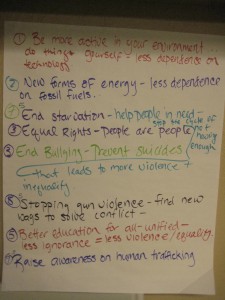
I also love to use peer-to-peer mentoring. Last week I had a new student in the group. Instead of talking her through everything that was going on and teaching her how to use a camera, etc., I asked the other students to show her. That’s a great way of helping students to assume some leadership and to validate their knowledge. Every time I see an opportunity for that kind of leadership challenge I try to use it.
I pride myself on the success rate of our program and on the fact that the students get so much more out of the experience than just film-making skills. They get to bond with each other and to play and be creative and perhaps most importantly, to really be seen by their peers.
I also find that it’s important to recognize different learning styles. Students learn, listen, contribute and process in many ways. It’s really important to remember that. A few years ago I had an idea of how to address students that were fidgeting or making noise while I was trying to teach. I would reassure them that I knew they were listening (visual learners are often the fidgeters or doodlers) and then I asked them if they would like a ball of clay to play with. They were always really surprised that instead of being in trouble I was encouraging them to build a healthy relationship with their own unique style of listening and learning. By offering them a quiet way to keep their hands moving, they are able to better concentrate and it stops them from distracting others. There are always different learners in the room and we as educators need to constantly dedicate ourselves to finding ways to engage them.
What I love about the way I’ve learned to facilitate and teach, both from the Creative Community Model and through my experiences, is that it’s all about being on the side of the student. I don’t practice the ‘my way or the high way’ technique. I believe that I learn as much from my students as they learn from me and I try to be very transparent when I don’t know something. I like to show them a different side to being an adult – a side where teachers don’t have to be perfect and where we are all learning and growing together.

